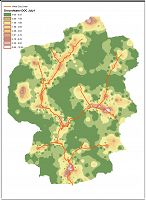PIHM_DOC
Penn State Integrated Hydrological Model for Dissolved Organic Carbon
PIHM is a physically based, fully distributed hydrological model
Model Category: Numerical
Image: DOC concentration distribution in groundwater for White Clay Creek watershed simulated by PIHMdoc
-
Christina, GRAD STUDENT
-
Christina, INVESTIGATOR
-
Christina, INVESTIGATOR
-
Christina, INVESTIGATOR
-
Christina, INVESTIGATOR
-
Shale Hills, INVESTIGATOR
-
Calhoun, INVESTIGATOR
-
Shale Hills, GRAD STUDENT
-
Shale Hills, COLLABORATOR, GRAD STUDENT
The objective is to integrate feedbacks among the three major processes governing the critical zone — the water cycle, the mineral cycle, and the carbon cycle. This requires a reliable model framework that can coupling the major processes. The Penn State Hydrological Model (PIHM) was adopted as our modeling framework to achieve the goal. Ultimately we envision integrating a large number of high resolution GIS, satellite data, and meteorological data for the mesoscale watershed and using PIHM to scale sediment and carbon fluxes across the basin. The physical mechanisms involved in all of the complex processes involved can only be investigated holistically by exploring results from such an integrated model.
To achieve our goal, the first step is to integrate all the GIS data (e.g., land use, soil type, DEM), into the model framework, and simulate the water flow and mass flux across the watershed. To date, we have successfully set up the PIHM for the mesoscale watershed simulation. The 1440 km2 watershed was divided into over 4000 mesh triangles (Figure 1). Stream discharge data from ten USGS stream stations within the Christina Basin were used to guide the model development. In the next step, we intend to incorporate high resolution RADAR-derived, gauge-calibrated precipitation datasets with PIHM to explore the hydrological response to the model up scaling at the basin scale. After the PIHM model calibration, we will integrate the PIHM model with a biogeochemistry model, DOC model, and sediment transport model (all these models are already available from the PIHM group at Penn State University) and finally do the basin scale sediment, carbon flux calculation.
The finding of this research will (i) advance our knowledge of the mesoscale carbon cycling and budget, and cast light on the effects of climate change on the regional carbon cycling; (ii) understand the fate and transport of sediment at basin scale; and (iii) test our hypothesis that the primary factor limiting organic carbon stabilization and preservation in a wide range of environments are insufficient supply, mixing, and complexation with mineral surfaces and polyvalent metals.
Figure 1. Spatial domain decomposition of the whole watershed in PIHM.
Explore Further














